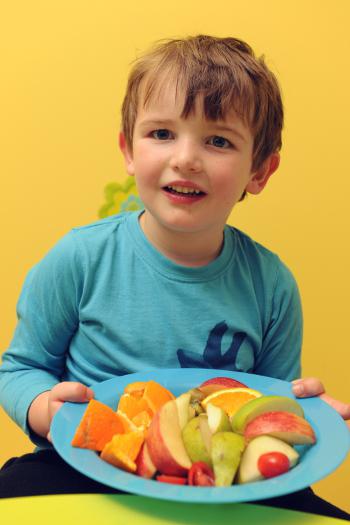Getting food out ready to eat
Duration/age

Ask your child to help you find the food or ingredients you will need for the meal. Talk with your child about what you are doing. Is the meal ready-made or does it needs to be made from scratch? If it is ready-made where is it kept? If it is not ready-made where are the different ingredients stored? What order will you need to collect the ingredients in?
Let’s get out the vegetables first but wait to get the cheese out as that needs to be kept cold.
Skills this activity improves
Why does this matter?
When children help you to get organised to eat or prepare food they are learning to quantify and compare their worlds by following instructions. They are using problem-solving skills to work out what needs to be done and in what order. They notice attributes and learn to classify them based on the sameness or difference of the attributes.
What does this lead to?
This activity leads to an understanding about measurement, identification of patterns and spatial awareness. Through listening to instructions children are learning to follow direction and to predict the order and sequence that events may happen in.
Language to use
- Long, short
- Thick, thin, flat
- Top, bottom
- Under, between, next to
- How much, all of, some, more, less
- First, last, next, wait, after, before
- Hot, cold, room temperature
- In the fridge, in the cupboard, in the fruit bowl
- Fruit, meat, vegetables, oil, frying pan, spaghetti
- Centimetres, kilograms, degrees
Questions to use
- How many do we need?
- Where will we find the microwave dishes?
- How much do we need?
- Where are the cold things? Where are the hot things?
- What should we do first? What should we do last?
- What kind of pasta shall we use?
- What could we use instead?
- What did we use last time?
- Which is heavy? Which is light?
Useful tips
- Keep instructions simple. If your child is under three they will just be beginning to listen and respond to questions and instructions.
- If your child is under three they will find it easier to grasp and hold smaller and lighter items.
- You might also like to look at the Unpacking the shopping activity.
- Remember to talk to your child in your home language.
More ideas
- Create baskets of different types of plastic food for your child to sort.
- Collect jars of different shapes and sizes. Your child can fill them up using different shaped and sized objects.
- Cook with your child.
- Set up scales and different things to weigh.
Variation by age
Birth to two year olds
- Sort the food by type, such as all the fruit, all the vegetables, all the things in packets.
- Count out the different food ingredients as you get them out.
- Ask questions about size and shape.
- Find food ingredients by colour.
Three to five year olds
- Sort the types of food using several attributes, such as cold and long, round and red.
- Ask questions about size, quantity and temperature.
- Play an eye-spy game using the attributes of temperature, position and size.
Questions to ask
- Which one is smaller? Which one is bigger? Are they the same shape?
- Are they the same or different?
- How many potatoes are there?
Questions to ask
- Will the bigger one weigh more?
- Should we put all the same types of food in together?
- What would happen if we took one away?


